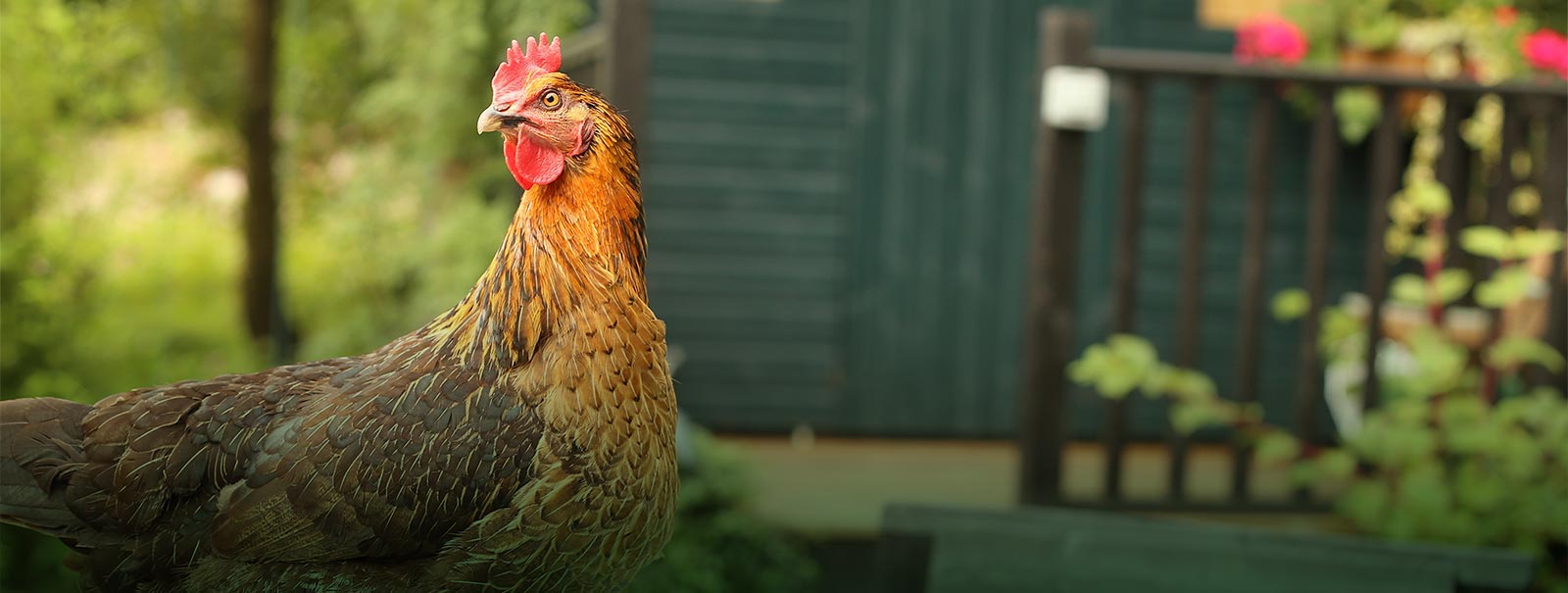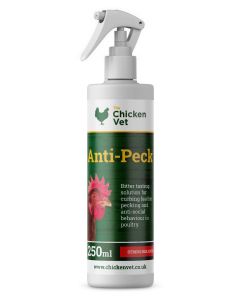
The advice hub Feather Loss
Moulting, Pecking and Feather Damage
Cause
Several possible causes:
- Moulting is a natural annual process where your chicken replaces its entire compliment of feathers over a few weeks. In a moult you will see new feathers beginning to appear.
- Stress such as extreme heat, water or food deprivation and illness can induce moulting.
- Pecking feathers out by other chickens around the vent or on the back is usually caused by stress, boredom or protein deficiency.
- Cockerels can damage feathers on a hens back during mating.
- Mite or lice infestation.
What to look out for:
- Pecking one another.
- Bald batches around the head, back or vent.
- Feather eating off the floor and feather pulling from each other.
- A cockerel preferentially and excessively mating with one hen causing bald patches over the back or the back of the head.
Treatment
Depends on the specific cause.
Moulting
Administer Chicken Vet Poultry Multivitamins as this helps provide the bird with additional support from protein whilst it’s trying to replace its feathers (feathers are more than 80% protein). Administer in drinking water for up to 5 days, with fresh solution made up daily.

If dietary protein deficiency
Ensure you are providing a correct and balanced diet; feed a good quality layer pellet from a reputable supplier. Chickens need specific levels of protein made up of a combination of amino acids and it is imperative these are met otherwise they will seek protein from elsewhere – the feathers! Chickens will pick them up off the ground and eat them, this leads on to the chickens plucking them out of themselves or their flock mates.
If pecking from other birds is the cause then you can also provide additional protein in the form of Chicken Vet Poultry Multivitamins. The pecked chicken will need to replace lost feathers and a preventative way of protecting it from other birds is to spray Chicken Vet Anti-Peck onto it.
Vent pecking
Vent pecking can lead to the offender causing severe blood loss and death. This type of pecking starts out of curiosity and is non aggressive, however chickens like to peck at red objects. When birds lay, their vents are often swollen and red for a few hours. This causes other chickens to investigate and may begin pecking leading to damage around the vent area.
Vent pecking can be avoided by darkening the shed or nest box area so the swollen vent is not as visible. Painting the windows can reduce the light level too.
Aggressive pecking
Initially birds can develop feather sucking or pulling due to boredom. The main reasons for this are:
- Lack of space.
- Unsuitable environments creating boredom.
- Being shut in for long periods of time.
- Bullying from birds higher up the pecking order.
- High daylight levels shining in to the coop.

A patch of feathers in a certain area will usually be targeted, commonly at the base of the tail or on the flanks. If the bird draws blood or damages the skin then it will immediately act as an attractant to other birds.
Aggressive pecking is commonly instigated by dominant birds asserting their authority. It is often directed at the victim’s head and consists of one hard peck which can cause damage, the victim retreats and so the natural order is resumed. Often this is a one off peck and isn’t a real problem. However, this can get out of hand and eventually cause injury, leading to cannibalism and in extreme circumstances death.
Pecking can become a problem when new birds are introduced to a flock; try putting the new birds in a cage within the coop. The other chickens can see you renew introductions but not peck. After a few days they can be let in together. Alternatively, add new chickens at night, carefully placing them on the perch. Usually all the birds settle down with only minor upsets.
Occasionally high levels of light may shine into the coop which birds generally don’t like. They feel safer in shady areas, so the light levels can cause stress.
Feathers are made up of 80% protein so they need additional protein during the regrowth phase. Ensure you feed a good quality ration to your poultry and do not make up your own ration or feed excessive corn and titbits, as it can lead to deficiencies and obesity. Low salt can also cause a similar problem.
Prevention
Providing your birds with an enriched environment will reduce the incidence of pecking due to stress. Distractions such as cereal blocks, hanging up fresh greens, nailing up a swede cut in half and giving the chickens plenty of area to range and forage will all help.
Chicken Vet Anti-Peck Spray can be sprayed on the affected areas of pecked birds and the rest of the group all over (to prevent more birds being involved with feather damage) for 7 days. Anti-Peck has an unpleasant taste, discouraging the other birds from pecking one another.
If cockerel damage is a problem then it’s best to first check if the cockerel’s spurs are the issue. These can be trimmed back using strong nail clippers. If in doubt take to your vet for them to carry out the trimming. If the damage is very evident, remove the damaged hen and let her recover in a separate area and use Chicken Vet Poultry Multivitamins to encourage feather regrowth and aid her recovery.



